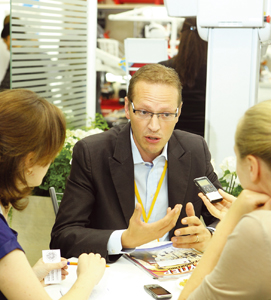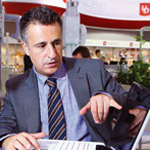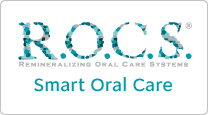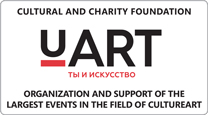John Fachchin: We Regard Furniture to Be a Dentist's Working Tool
 Dental Art is known around the world as a
manufacturer of the most modern and at the same time exquisite furniture for
dental clinics. The company creates not only unique design solutions, but also
a space arrangement phylosophy in general. The Dental Art's phylosophical
system always brings to the fore the doctors and doctors' everyday tasks, to
solve which Dental Art involves innovation technologies. We discussed the
process of creating unique furniture with John Fachchin, the company's Director
for Exports.
Dental Art is known around the world as a
manufacturer of the most modern and at the same time exquisite furniture for
dental clinics. The company creates not only unique design solutions, but also
a space arrangement phylosophy in general. The Dental Art's phylosophical
system always brings to the fore the doctors and doctors' everyday tasks, to
solve which Dental Art involves innovation technologies. We discussed the
process of creating unique furniture with John Fachchin, the company's Director
for Exports.
— Year after year, Dental Art brings new
designer and technological solutions into the work of dental clinics. What
solutions do you consider interesting and important?
— As far as furniture manufacturing is concerned, we have innovations that
one could call unique. Take the new model of Zero hygienic modules: it is
not alike any other product of similar purpose already present in the dental
market. Such projects as Zero are of primary importance for our company,
because Dental Art positions itself as an innovating manufacturer in the
global market.
— I think you were the first company to create a
product line like Epta Movï.
— Some elements of the line already existed in other,
 We’ve found a new,
We’ve found a new,
Considering such product line as Fringe, we can mention new solutions in
manufacturing, which make difference to the quality. Development of a product
within the price range of a previous line, but superior in quality requires the
introduction of new technologies in the manufacturing process.
This fact will pass unnoticed by the end user, but such solutions are of major
importance for the company.
— When was Dental Art established?
— The company was founded in 1966; it was named Dental Art and was
based on a small enterprise engaged in the production of goods for kitchen.
Later, in 1976, with the arrival of a new partner already working in
the dental market, we decided to start producing metal products for dentistry.
Since then the company specializes in the manufacture of furniture for
dentistry exclusively. We also have a line of furniture for reception with some
accessories to it, but its share in the production is of course much less
compared to dental furniture.
Typically, the reception furniture is a part of general projects to equip
some new clinics. The first Dental Art's market was Italy, then we
approached the German market, the company began to gradually build production
and we started to export to different countries.
 — One, probably, needs a large creative team to
introduce new lines?
— One, probably, needs a large creative team to
introduce new lines?
— The company employs two people who specialize only in developing new
products. Our products do not fall into the “standard” category, so we have
three designers, who create designs on orders, and another three people are
preparing sketches. To find out an opinion of an independent designer or
obtain some new ideas
Definitely, we expect that the designer will be able to propose something completely new. At the same time, it is very important to get feedback from the sales group, to understand what the consumer wants, and from the manufacturing department, which is to confirm that the customer's desire is technologically feasible. This requires a real team effort, involving at least six to seven people.
— How long, on average, does it take to create a
new line?
 — Speaking of such line as Fringe, which brings together a number of
components, its creation involved many people. From my own experience, I can
say that it is impossible to fully realize such a project in less than one
year. Sometimes it takes even longer. We pay a lot of attention to details,
which are important for dentists, because it is for them that Dental Art
creates its furniture. That is why we focus our attention on hygienic
characteristics and cleaning efficiency. Time is also consumed in
engineering small parts.
— Speaking of such line as Fringe, which brings together a number of
components, its creation involved many people. From my own experience, I can
say that it is impossible to fully realize such a project in less than one
year. Sometimes it takes even longer. We pay a lot of attention to details,
which are important for dentists, because it is for them that Dental Art
creates its furniture. That is why we focus our attention on hygienic
characteristics and cleaning efficiency. Time is also consumed in
engineering small parts.
Thus, we use special terminal units and plugs, so that when you close a drawer,
it performs silently and smoothly. These details are not visible, but they are
indispensable in use. We can make them as most companies do: applying minimum
efforts just for the sake of appearance, but Dental Art pays a lot of
attention to this area, because we regard furniture to be a dentist's working
tool.
— We have visited your production floor, and, as
far as I remember, there were fewer workers than machines.
— Our company has two manufacturing departments. One of them makes all
metal parts: performs metal cutting and painting. Technology and equipment are
of great importance for this department. Our assembly department employs more
staff, as they bring together individual parts making sure everything is in
perfect condition before shipment.
 — In which countries Dental Art enjoys the most
popularity? And what can you say about the Russian market?
— In which countries Dental Art enjoys the most
popularity? And what can you say about the Russian market?
— Our main market is still our domestic market — Italy.
Speaking of Russia, the first thing to be noted is that here we use a different
strategy to maintain the level of sales, because we work only with UNIDENT on
exclusive terms. And I believe that the considerable results we achieved here
will be multiplied in future. Of course, this is all thanks to the UNIDENT's
marketing strategy: exhibitions, publications and the attention paid to the
products at large. The Russian market is peculiar, so we need a partner, who is
aware of its specific features. In all such matters we fully rely upon
UNIDENT.
We see that in Russia our products is ranked among the luxury furniture
category, where design is important and Italian quality is recognized. In Italy
and in France in addition
— You work with customers from a wide range of
countries. Were there
any unusual projects that you
remember?
— For me the tender in Malaysia was unusual. We had to equip a laboratory,
and all our products were sent to a number of small Malaysian islands.
Sometimes, to get to a clinic, we had to go on a boat with all these big boxes
and large furniture. For me, let me stress, for me personally, it meant
completely new circumstances and experience. Just imagine: an advanced
laboratory,
 Sometimes we
receive orders
Sometimes we
receive orders
Dental Art has plenty of means for the implementation of ideas. Therefore,
if someone wants to get the best result in terms of aesthetics and
functionality, we are able to offer a great deal. It was a great pleasure
implementing a project in the United States for one of the best labs
I've ever seen. Everything was performed
 — For
UNIDENT, Dental Art is primarily associated with you personally. Will you
please tell us, when you started working for Dental Art.
— For
UNIDENT, Dental Art is primarily associated with you personally. Will you
please tell us, when you started working for Dental Art.
— I joined the company in 1997. For the first three years I was dealing
with the quality management system: certification, ISO 2001, quality control
and all related matters. Then I moved to the export department and in a few
years became its head. Thus, I've already worked 15 years for the company, of
which 9 years I've been engaged in foreign trade. It is an interesting job.
Surely, there are markets in which we have been operating for many years, and
we need to maintain and develop them. At the same time, recent years brought
the opportunity to enter new markets and gain new experience. I like doing
this.
— You
— …two years and nine months.
— How do you feel being a father? Did this role
give you anything new? What personal changes did it bring — at work and at
home?
— I
believe, that every father and every mother will say that the arrival of a baby
changes everything. This is hard to explain, but it is true: it changes the way
you feel about life, about your wife, there comes a sense of responsibility
that fills you. All this you get in doubled amount, because you have to think
about the future, plan how to grow and develop. The same concerns remain, but I
find it easier to understand some things. Similar to many children missing
their fathers, my son misses me. And I miss him. Sometimes I find it difficult
to cope with this feeling.
I
believe, that every father and every mother will say that the arrival of a baby
changes everything. This is hard to explain, but it is true: it changes the way
you feel about life, about your wife, there comes a sense of responsibility
that fills you. All this you get in doubled amount, because you have to think
about the future, plan how to grow and develop. The same concerns remain, but I
find it easier to understand some things. Similar to many children missing
their fathers, my son misses me. And I miss him. Sometimes I find it difficult
to cope with this feeling.
— John, thank you for the interview. It was
incredibly interesting to learn more about the company
— In my turn, on my own behalf and on behalf of Dental Art I would like to
wish UNIDENT further progress and I look forward to continued cooperation.
Back










